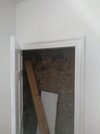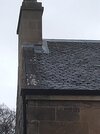Hi,
Got a bit of a leak coming in at the gable end wall upstairs. There was dampness in an old Edinburgh Press (shallow cupboard set into stone wall) which I thought was condensation and I ripped the wooden lining out to find a leak coming in from above. No dampness or water ingress at all in the attic space above, and as the cupboard recessed into the wall, I presumed it was probably coming in at the skew stones and seeping down the inside of the wall until it hits the open space at that cupboard.
House is at least 150 years old with slate roof,
Got one roofer out and he seems to have come to a similar conclusion. He said that he couldn't see any issue with the cement skews/fillet, but that the stones become porous with age. His suggestion is to cover the stones completely with lead, running under slate, and I am now awaiting quote.
Just wondering if there are any thoughts/alternatives or things that I should consider.
Thanks.
Got a bit of a leak coming in at the gable end wall upstairs. There was dampness in an old Edinburgh Press (shallow cupboard set into stone wall) which I thought was condensation and I ripped the wooden lining out to find a leak coming in from above. No dampness or water ingress at all in the attic space above, and as the cupboard recessed into the wall, I presumed it was probably coming in at the skew stones and seeping down the inside of the wall until it hits the open space at that cupboard.
House is at least 150 years old with slate roof,
Got one roofer out and he seems to have come to a similar conclusion. He said that he couldn't see any issue with the cement skews/fillet, but that the stones become porous with age. His suggestion is to cover the stones completely with lead, running under slate, and I am now awaiting quote.
Just wondering if there are any thoughts/alternatives or things that I should consider.
Thanks.



